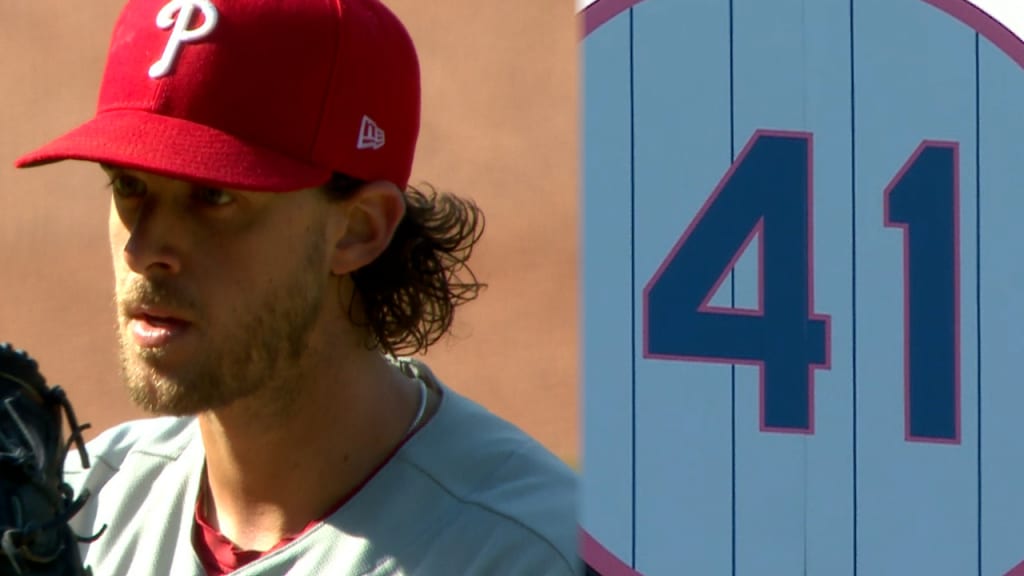Why Nola is primed to bounce back in '22
This browser does not support the video element.
PHILADELPHIA -- Workhorses still matter to some people.
They certainly matter to the Phillies, who have two of the best in baseball in Zack Wheeler and Aaron Nola. Wheeler finished second for NL Cy Young to Milwaukee’s Corbin Burnes on Wednesday. It has been an intensely debated result because while Burnes led baseball in ERA (2.43), strikeout rate (35.6 percent), strikeout-to-walk ratio (6.88) and FIP (1.63), Wheeler led baseball in innings pitched (213 1/3), complete games (three), shutouts (two), batters faced (849) and bWAR (7.6). He also led the NL in strikeouts (247). Nick Pollack at PitcherList.com tweeted that while Wheeler pitched 27 percent more innings than Burnes, he finished with an ERA only 12 percent higher than him.
In other words, Wheeler got penalized for pitching more often and deeper into games. Wheeler would have had a 2.32 ERA, if he never threw a pitch after the sixth inning. Burnes’ ERA would have been 2.34.
Phillies president of baseball operations Dave Dombrowski will happily take the second-place Cy Young workhorse in his rotation. He will take Nola, too. Nola is second in baseball in innings pitched (666 2/3) the past four seasons. Only Gerrit Cole has thrown more (667).
Wheeler, by the way, is third (662).
Nola, like Wheeler, has been a topic of conversation for months in Philadelphia, albeit for different reasons. Nola struggled in 2021, going 9-9 with a 4.63 ERA in 32 starts. People want to know why.
“Not that great, honestly,” Nola said following his final start in October. “Up and down. Yeah, I guess just up and down.”
But there are reasons to think that Nola will bounce back. Nola posted a 4.63 ERA, but he also had a 3.39 xERA, 3.37 FIP (Fielding Independent Pitching) and 3.47 DRA- (Deserved Runs Average). Expected ERA is Statcast’s ERA estimator. It is based on quality of contact, plus walks and strikeouts. FIP is from FanGraphs. DRA- is from Baseball Prospectus.
Each tells a different, but similar story.
In short, Nola probably should have posted a better ERA than he did.
Only Andrew Heaney had a larger gap (1.85) between his actual and xERA in 2021 (5.83 ERA vs. 3.98 xERA).
Nola’s gap was 1.26.
Eduardo Rodriguez ranked third at 1.22 (4.74 ERA vs. 3.52 xERA).
Perhaps it is no coincidence that Heaney and Rodriguez were two of the first starting pitchers to sign free-agent contracts in the offseason. Heaney signed a one-year, $8.5 million contract with the analytics-savvy Dodgers. Rodriguez signed a five-year, $77 million deal with the Tigers.
You can bet if the Phillies told teams they wanted to trade Nola, they’d get a ton of interest.
So why Nola’s ERA vs. xERA discrepancy?
Nola had a career-low groundball percentage and a career-high in-zone swing percentage. Both probably hurt him to some degree. Cozy Citizens Bank Park wasn’t an issue. He had a better ERA at home (3.86) than on the road (5.27). He had a .308 BABIP, which is high, but not ridiculously so.
Perhaps surprisingly, it wasn’t the Phillies’ defense. It performed roughly average when he was on the mound.
So then what was it?
Simply, it might be really bad timing on mistake pitches. Nola pitched fine without runners on base, certainly compared to other seasons. But when Nola had runners on base he got hit hard. It was the second-worst mark of his career. And when he had runners on base with two outs, it was the worst mark of his career.
Nola allowed a National League-leading 82 two-strike hits. Three of his 82 two-strike hits were 0-2 home runs.
This browser does not support the video element.
“It’s the home runs with guys on base,” Nola said. “It’s that one big inning mainly. I’ll go back and look at all the starts, but what comes to mind is that one big inning that hurt me. The two-, three-run homers hurt me. I take those out or get better at those next year and it’s obviously a better year.”
His Phillies teammates agree.
“I can think of countless times when he gave up a two-out hit that either scored a run, led to a homer or cost him a lot of runs,” J.T. Realmuto said. “He had an unlucky season. I think he pitched a lot better than his ERA showed. For me, there’s some small things that, focus-wise, just certain counts, being a little bit more diligent. In my opinion, he had a great year, even if the ERA doesn’t suggest it.”
“I don’t think he had a down year,” Wheeler said. “It’s been late in games, right? That stinks as a pitcher. You’re going great, then late in the game you hang one curveball and a guy hits a two- or three-run home run and they go up by one or two. His walks were down, his strikeouts were up. He gave us innings. He’s that guy you need. It was just a weird year for him.”
